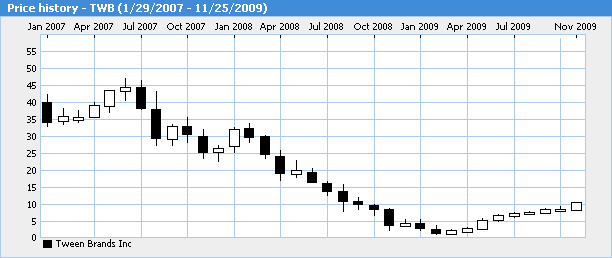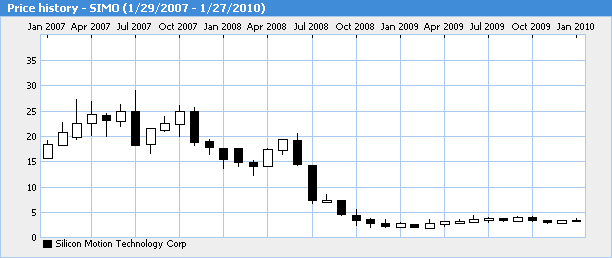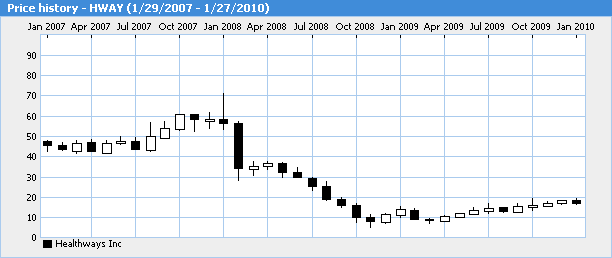买股票容易,但是,什厶时候该卖出自己所持有的股票。一直是困扰投资者的一个大难题。下面这篇文章给出了三个衡量标准,我觉得有些道理,放在这里供大家参考。为了读者理解方便,后面我还同时加上了相关的股市变化图。 最近在这个网站的博客贴中文老出问题,也就懒得写了。我真的不明白,为什厶这个网站的“经营者”就那厶懒,或者叫做愚笨,不将这种问题解决了。贴中文博客出现乱码,对我来说这还是唯一一家。 3 signs you should sell a stock By Harry Domash Successful investing is about avoiding disastrous losses. Here's how to spot clunkers before their prices tank. Shareholders of companies as diverse as Healthways (HWAY, news, msgs), Silicon Motion Technology (SIMO, news, msgs) and Tween Brands (TWB, news, msgs) have all suffered big losses in recent weeks after those companies reduced forecasts or produced results that fell below the market's expectations. But that sort of bad news doesn't have to be a surprise to you. Many times, checking a company's earlier quarterly reports for telltale signs that something is amiss will alert you to future problems. Those checks are vital because, in the market, such shortfalls often spell big trouble for shareholders. How to know when to sell Here's how to identify three of those telltale signs, or red flags, that warn of future bad news. You can do the checks using the financial statements on MSN Money. You'll need a calculator, but the calculations are easy. Once you get the hang of it, you'll be able to do the analysis in less than five minutes. Considering the consequences of not doing the calculations, I'm sure you'll find them well worth the effort. Margins I'll start with margins, which are useful for detecting deteriorating competitive or operating conditions. Margins are the profit a company makes on its sales. For example, a 25% margin means the company is making 25 cents for every dollar of sales. Gross margins are a measure of profit before a company accounts for overhead, marketing, research and development, interest and taxes. Rising gross margins tell you a company is reducing production costs or raising prices. Conversely, deteriorating margins say either that production costs are increasing and the company can't raise prices proportionally or that the company is cutting prices in an attempt to maintain market share. Operating margins are a gauge of profit after a company accounts for overhead, marketing, and research and development. Rising operating margins generally indicate the company is operating more efficiently. However, falling operating margins signal something is amiss. Often, operating margins drop because the company has to increase advertising and other marketing expenses to maintain sales growth. Margins tend to move in trends. That is, if margins rose in the previous quarter, they will probably be even higher in the current report. That's good news because rising margins usually lead to positive earnings surprises. Margins might fall for innocuous reasons, such as expenses related to a new product's introduction. However, falling margins, either gross or operating, often signal a declining competitive position. Thus it's important to check both. Finding the sweet spot Calculate gross margins by dividing gross operating profit by sales for the same period. Calculate operating margins by dividing operating income by sales. You can find all three items on MSN Money by looking at quarterly income statements. To rule out seasonal variations, always compare the most recent quarter's margins to the year-ago quarter. I'll use specialty retailer Tween Brands to illustrate the process. Tween's share price dropped more than 30% after the company reported disappointing quarterly results in July. So we would have relied on its April quarter report to detect red flags warning of that event. Find the income statement in the Financial Results section under Statements. The default is an annual income statement. To analyze margins, select the quarterly income statement, which lists data for the past five reported quarters. For Tween Brands' April 2008 quarter (which actually ended May 3), the income statement listed revenue (sales) of $251.74 million, gross profit of $86.34 million and operating income (profit) of $8.45 million. So the gross margin was 34.3% (86.34 divided by 251.74), and the operating margin was 3.4% (8.45 divided by 251.74). Doing the same calculations for the April 2007 quarter yielded gross and operating margins of 37.9% and 8.1%, respectively. (Because the statement lists only the five most recent quarters, the April 2007 data disappeared when the July 2008 results were posted. So you won't be able to check my math for April 2007.) First red flag: Deteriorating gross and/or operating margins Tween Brands' April 2008 gross margin dropped to 34.3% from the year-ago 37.9% figure. That's a 9.5% drop. Small changes in gross margins translate to big changes in reported earnings. Consider a year-over-year gross-margin drop of 5% or more (for example, from 20% to 19%) a red flag. Tween's operating margin dropped 58% (3.4% versus 8.1%). Operating margins are more volatile than gross margins, so they require more leeway. Consider a 20% drop in operating margins (for example, from 50% to 40%) a red flag. However, treat a 10% drop as a "yellow flag" that requires scrutiny. Receivables Corporations usually don't pay cash when they buy from another company. Instead, they have a predetermined time, such as 90 days, to pay for the goods. The amounts owed to a company by its customers for goods received are termed accounts receivables. Usually, receivables track sales. For instance, if a company sells twice as much as it did the year before, you would expect its receivables to double. Sometimes sales grow faster than receivables, which signals the company is doing better at collecting its bills, which is good. But beware when receivables increase faster than sales. That means customers are taking longer to pay their bills. Here are three reasons that could happen: The company is slow in billing its customers. Customers don't have the cash to pay. The company is giving customers longer payment terms to encourage them to order the products they don't need right away. Though No. 1 is fixable, reasons No. 2 and No. 3 will likely result in future shortfalls in sales and earnings. To analyze receivables, compare the ratio of receivables (balance sheet) to sales (income statement) for the most recent quarter to the year-ago ratio. I'll demonstrate using Silicon Motion Technology. Silicon Motion's share price took a big hit after the Taiwanese chip maker reported disappointing June 2008 quarter results. Here's what you would have found if you had analyzed Silicon Motion's receivables after it released its March 2008 quarter's results: For the March quarter, Silicon Motion's sales totaled $1.586 billion (in Taiwanese dollars), and its receivables at the end of the quarter totaled $920.3 million (a Taiwanese dollar is worth about 3 U.S. cents). So the ratio of accounts receivable to sales, or AR/S, was 58% (920.3 divided by 1,586). The same calculation for the March 2007 quarter yielded a 44.2% figure. Thus Silicon Motions' receivables increased to 58.0% of sales in April 2008, up from 44.2%. Second red flag: Accounts receivables versus sales Consider a 20% increase in AR/S (for example, from 50% to 60% or from 10% to 12%) as an accounts-receivables red flag. Silicon Motion's ratio increased 31% (58.0 versus 44.2), which more than qualified for red-flag status. Count the cash Cash flow is the cash that moved into or out of a company's bank accounts during a reporting period. Because cash flow must be reconciled with actual bank balances, it is a more reliable measure of a company's results than reported earnings, which are subject to arbitrary accounting decisions. Operating cash flow is primarily net income with noncash accounting entries such as depreciation expenses added back in. Generally, operating cash flow should exceed net income. But many companies report positive net income when, if you count the cash, they are actually losing money. Academic research has found that comparing reported net income with operating cash flow is a good way to spot future problems. Specifically, the researchers found that a situation in which net income grows but operating cash flow doesn't is a red flag pointing to future earnings shortfalls. Interpreting a cash-flow statement is a little tricky. The quarterly statements show the cumulative year-to-date totals for each quarter instead of each quarter's individual figures. For instance, if a company's fiscal year starts in January, its June-quarter figures include the total of the March and June quarters. To get the June quarter's operating cash flow, you would have to subtract the March totals from the June totals. However, there's no particular advantage to analyzing the quarters separately. So I make it simple and compare the most recent quarter's numbers to the year-ago figures, regardless of whether they represent single or multiple quarters. Thus you need only compare the change in net income with the change in operating cash flow from the year-ago quarter to the most recent quarter. To illustrate, I'll use Healthways. Shares of the specialty health care services company recently dropped 20% after it cut its forecasts for future quarters. Here are the numbers you would have found had you checked Healthways' cash-flow statement after it reported its May 2008 quarter results: | | Net income | Operating cash flow | | May 2008 | $37.6 million | $69.3 million | | May 2007 | $33.7 million | $70.3 million | Third red flag: Rising net income combined with a decline in operating cash flow Healthways' May 2008 net income rose 12% over May 2007, while its operating cash flow dropped slightly over the same period. It's a red flag if net income increased from a year ago but operating cash flow didn't grow. Consider it a yellow flag requiring attention whenever net income exceeds operating cash flow. Better safe than sorry Nothing always works in the stock market, and these three red flags are no exception. Sometimes cash flow drops because a company loads up on inventory for a new product or because gross margins drop under short-term conditions. In today's weak economy, I'm seeing this a lot. Nevertheless, successful investing is more about avoiding disastrous losses than it is about riding hot stocks. Paying attention to these red flags will help you do that. 


|
